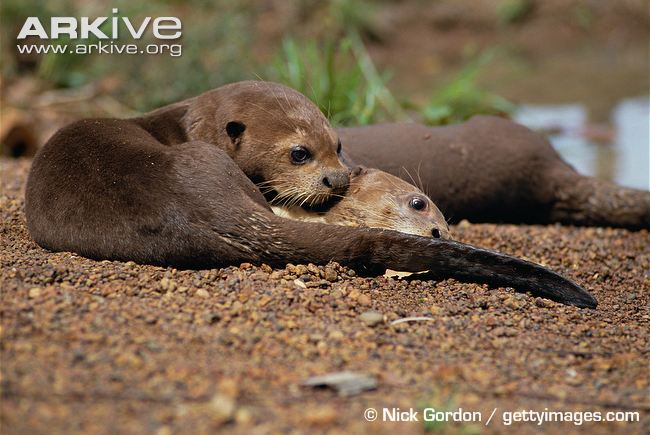Classification
Pteronura brasiliensis is the Latin name for giant river otter, in which Pteronura means wing or feather, and brasiliensis means Brazilian. The reference to a wing, or feather, refers to the giant river otter's tail, which helps to propel it through the water, and what a coincidence! The giant river otter inhabits Brazil!
Domain-Eukarya
Kingdom- Animalia
Phylum- Chordata
Class- Mammalia
Order- Carnivora
Family- Mustelidae
Subfamily- Lutrinae
Genus- Pteronura
Species- Pteronura brasiliensis
Here is the breakdown of the taxonomic levels to which the Pteronura brasiliensis belongs to.
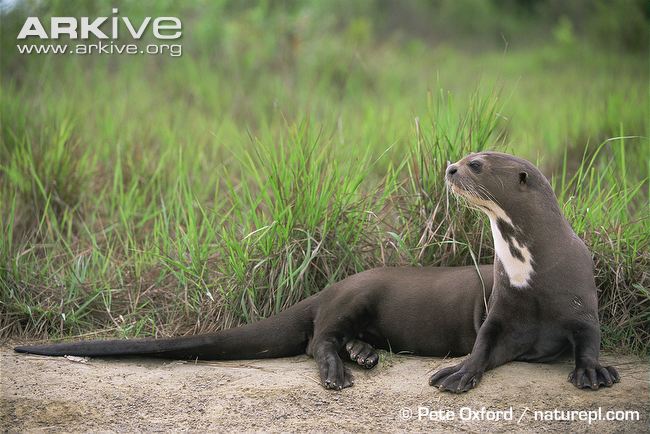 Domain-
Eukarya
Domain-
Eukarya
Eukarya have cells that contain organelles and also a
nucleus that holds its DNA. An interesting fact: eukaryotes went
through endosymbiosis to obtain their mitochondria and chloroplasts;
this means some Eukarya are photosynthetic.
Kingdom- Animalia
Animals are multicellular organisms
that are motile at some point during their lifetime and lack cell walls.
They are also heterotrophs, so they can't use sunlight to produce
their own food.
Phylum- Chordata
Be aware of the Chordata! This phylum
consists of the lurking amphibians, reptiles, and mammals, as well as
colorful fish and birds. They all possess muscular tails
and pharyngeal gill slits, and don't forget the notochord that
runs along their back, attaching to muscles in many chordates and
enabling them to move. All chordates have a dorsal hollow nerve chord
that lies just above the notochord. If you find the Chordata
interesting, visit this
webpage to learn about the great white shark,
one of many representatives of the chordates.
Class- Mammalia
Mammals are classified as endothermic
because they maintain body heat internally. Along with their inner
metabolic functions that produce this heat, they also have a soft coat
of fur to keep the warmth in. A little advice, don't try to sneak up on
a mammal. They're always listening! Mammals also have mammary glands
that are used to produce milk for their young.
If you want to learn more interesting facts about the anatomy of mammals, visit Dr. Jon A. Baskin's Biology website for
Texas A&M University of Kingsville
here!
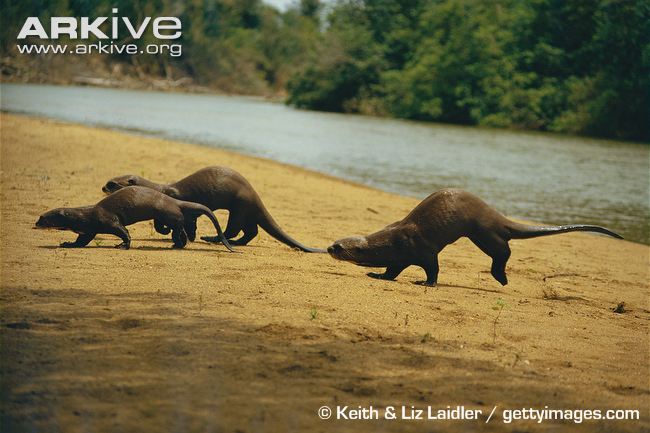 Order-
Carnivora
Order-
Carnivora
Carnivora is Latin for "flesh" and "to
devour." As you can tell from the root meanings of the Latin term, these
mammals eat meat, which means that they require razor sharp canine teeth
and claws. Like most other mammals, carnivores give live birth rather
than laying eggs. If you would like to learn more about mammals that
belong with the Carnivora, take a look at the cougar
here!
Family- Mustelidae
The mustelids consist of weasels, otters,
wolves, and martens. All members have an elongated, tube-shaped body
with stubby muscular legs and five retractable claws. Their small
rounded ears are the only innocent-looking characteristics they have,
for as soon as they open their mouths and show their menacing pointed
canines, it's enough to send anyone running for their lives. They also
have delayed fertilization, in which the embryo can remain dormant for
up to a year (Encyclopedia Britannica 2014). Check out this sea otter to learn more
about Mustelidae!
Subfamily- Lutrinae
The Lutrinae are a subfamily of
Mustelidae, and they are considered to be semi-aquatic otters. Their
diet consists mostly of fish, and they live near any freshwater land
forms.
Genus- Pteronura
The Pteronura brasiliensis
belongs to the genus Pteronura and is the only species within
this genus. Pteronura brasiliensis brasiliensis and
Pteronura brasiliensis paranensis are claimed to be subspecies of
the giant river otter because of their larger skull and varied
dentition, but there is not enough evidence yet to support this claim
(Pickles et al. 2011).
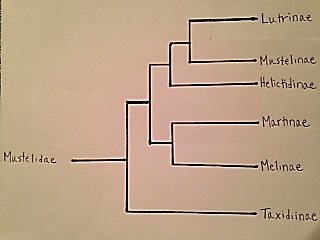 This phylogenetic tree shows the phylogeny of the subfamilies belonging
to the Mustelidae. This representation is based on the data
received from molecular testing of five nuclear genes within species in
each subfamily. However, it must be noted that this is just one of many
representations that could be created. Rapid species radiation makes it
difficult to test these species (Yu et al. 2011).
This phylogenetic tree shows the phylogeny of the subfamilies belonging
to the Mustelidae. This representation is based on the data
received from molecular testing of five nuclear genes within species in
each subfamily. However, it must be noted that this is just one of many
representations that could be created. Rapid species radiation makes it
difficult to test these species (Yu et al. 2011).
Within this phylogenetic tree, the giant otter would be part
of the Lutrinae within the Mustelidae. It shows the relationship between
otters,
weasels, badgers, wolves, and
martens. See this
website for
more information on the relationships between the giant otter and these
species!
Figure 1. Phylogenetic tree of the Mustelidae. Image by Alyssa Patten.
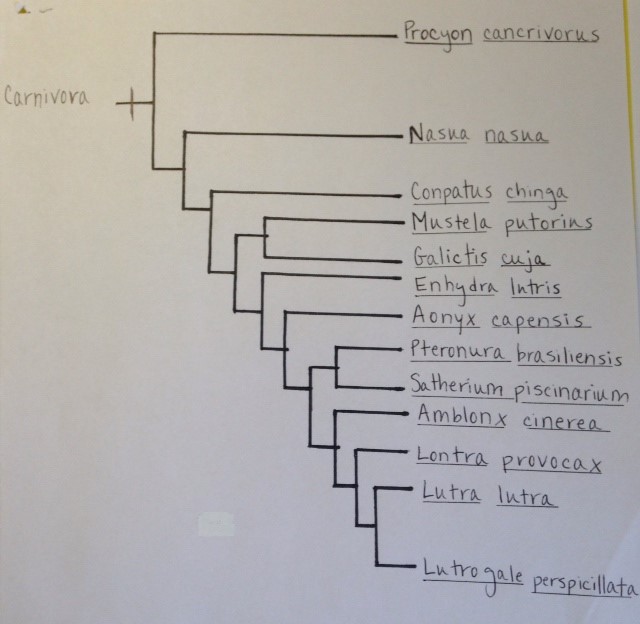
This phylogenetic tree compares fossils of different species among the families that make up the Carnivora. The placement of taxa were determined by the morphologies of dentition, mandibles, and skull size and shape (Prevosti and Ferrero 2008). As you can see, the Pteronura brasiliensis is shown to share a most recent common ancestor with the Satherium piscinarium based on similar morphologies.
Figure 2. Phylogenetic tree of
families within the Carnivora. Image by Alyssa Patten.
As you can tell from the classifications, the Pteronura brasiliensis is a very intriguing species! What's even more interesting is its habitat. Continue on to learn about where the giant river otter lives.
